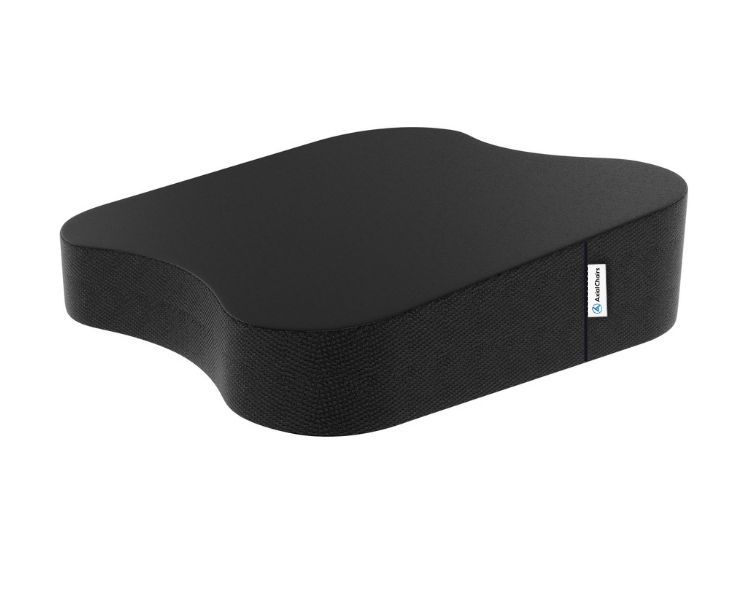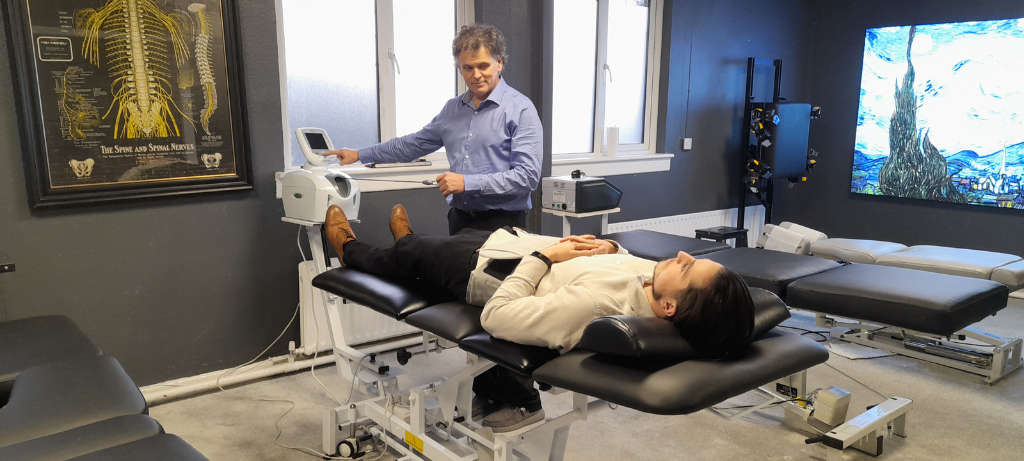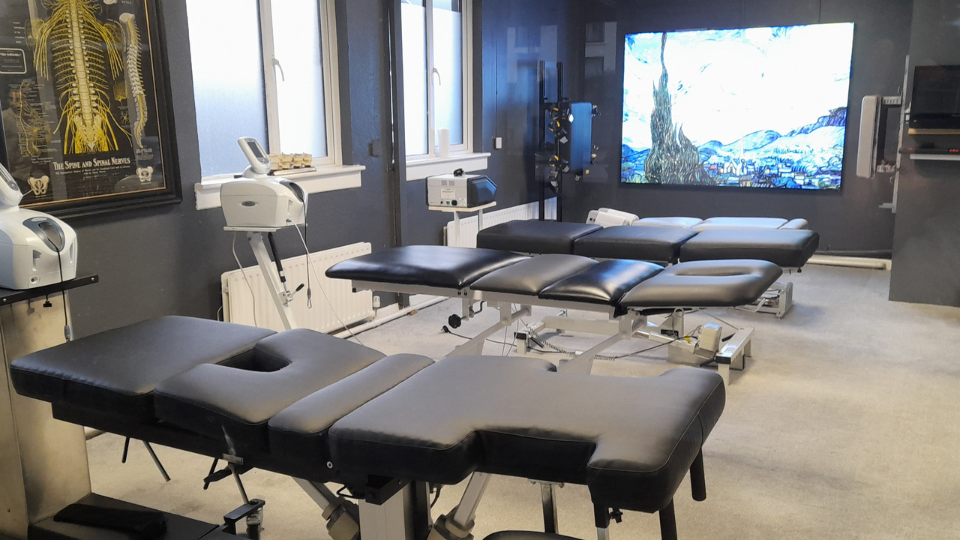As someone who has experience working in the medical field and has seen countless patients dealing with back pain, I can tell you from personal experience how much something as simple as decompressing the spine can improve both your overall quality of life and help in managing painful conditions. When done correctly, there are many significant benefits that accompany this practice – even for those suffering from long-term chronic pain. In today’s blog post, I am going to explain exactly what is involved in the process of spine decompression, why it works so well for relieving certain types of back pain and most importantly provide you with a few tips on how to do it safely so that you can make sure you get the most out of this therapeutic exercise.
As a general rule, using decompression therapy can help reduce chronic spinal pain by targeting the root cause. Stretching the spine, reduces pressure on discs and nerves, aiding natural healing without surgery or invasive procedures.
What is spinal decompression and how does it work?
Spinal decompression is a non-surgical therapy for back and neck pain that gently helps bulging or herniated discs return to their correct locations for long-term relief. It can provide many benefits for patients suffering from lower back pain associated with compressed or degenerated discs, herniated discs, bulging disc material, sciatica, spinal stenosis, and other conditions affecting the lower back. The process creates negative pressure in the affected area which helps to reduce inflammation and promote healing. This type of decompression spinal therapy has been proven to be safe and effective in treating cases of chronic back and neck pain without medications or surgery.
How often should I decompress my spine?
The frequency of spinal decompression therapy depends on various factors, such as the severity of the spinal condition, the patient’s age and overall health, and the treatment plan recommended by the healthcare provider. It is essential to consult with a qualified healthcare professional who can assess your individual needs and determine the appropriate frequency and duration of spinal decompression therapy. Generally, a treatment plan may consist of several sessions over a period of several weeks, with follow-up appointments as needed to maintain spinal health.
How to decompress the spine
When attempting spinal decompression, it’s important to do so gently and with the proper technique. As a chiropractor who has been treating back pain patients for almost three decades, I recommend that you first consult with your doctor or a certified chiropractor to ensure the procedure is right for you. With their advice and guidance, you can then begin a program of spinal decompression therapy which includes lying down on a specialized table and having it slowly stretch your spine in order to create negative pressure in specific areas. This helps bulging or herniated discs return to their correct locations and provides many benefits for patients suffering from neck or lower back pain.
How to decompress my spine while sitting?
5 Points to consider to potentially relieve disc pressure when seated:
- Seat height: Be sure you are seated high enough to ensure that your feet touch the floor and your thighs form an initial 90-degree angle while seated.
- Seat width: The chair’s surface area must be wide enough to support your entire bottom, but there must be a gap between the edge of the chair and the back of your knees of approximately 1-2 inches.
- Armrests: armrests help to support the weight of your arms and shoulders while seated, keeping your spine in a neutral position.
- Lumbar Support: Lumbar support helps to maintain the natural curve of your lower back.
- Seat angle: I found that this is a critical element that almost never gets discussed for back and neck pain sufferers; I found with my back pain patients with pressure mapping and sEMG scans that by changing the seat angle, their weight dispersed more into their muscles and less on their discs, leading to more comfortable positioning, better alignment, and greater engagement of the core muscles.
It is because of this that I’m different from your average cushion designer, bringing decades of experience to the table. My background as a chiropractor has given me a profound understanding of the human body, particularly how it relates to posture and sitting. This expertise has been invaluable in crafting ergonomic seat cushions that offer the ultimate comfort and support.
My passion for the craft is clear from my impressive track record. I’ve made appearances on various TV shows, authored a book on posture, and successfully raised funds through a Kickstarter campaign for my ergonomic seat cushions. I’ve even created a YouTube channel dedicated to sharing tips on how to improve posture and overall health.
My wealth of experience gives me a unique advantage over other designers. When developing my products, I carefully consider the combination of materials to create designs that are customized for maximum comfort while maintaining a healthy posture. Additionally, every design undergoes rigorous testing to ensure that it performs beyond customer expectations.
Overall, my extensive knowledge and dedication set me apart from other ergonomic seat cushion designers. Whether you’re looking for optimal comfort or seeking to maintain a healthy posture, my products are sure to exceed your expectations. It’s no wonder why so many customers rely on me for their seating needs!
All Day Comfort & Support
Axial Ergonomic Seat Cushion® | Seat Chair Wedge
Quick Guide: A 30-Second Summary

All Day Comfort & Support
Product Name
Axial Designs™ Seat Cushion
Price
$149
Warranty
1 Year
Type
Posture Wedge
Top Layer
100% Natural Latex (Molded)
Bottom Layer
High-Density Foam
Top Material
Isometric Grippy Vegan Leather
Bottom Material
Non-Slip Material
Side Material
3D Breathable Fabric
How to decompress the spine while sleeping
To decompress your spine while sleeping, I recommend using a chiropractic pillow or a bolster pillow to keep your spine in proper alignment. This will help relieve pressure on the disks and vertebrae while you sleep. Additionally, you may want to consider an adjustable mattress that has natural latex foam to provide increased comfort and spinal support throughout the night.
Spinal decompression at home
It’s generally not recommended to perform spinal decompression therapy at home, as it’s only recommended when non-surgical treatment options have been exhausted. However, if you do decide to pursue a nonsurgical spinal decompression program at home, it is essential that you first consult with your doctor or chiropractor for guidance and instruction on how to properly perform the pain spinal necessary procedures.
Pros and cons of spinal decompression
Pros:
• Can treat cases of back and neck pain without medication or surgery
• Been proven to be safe and effective in treating cases of chronic back and neck pain
• Nonsurgical spinal decompression aims to reduce pressure on the disks, vertebrae and spinal cord
• Can provide long-term relief from lower back pain
• When combined with chiropractic care, can provide additional pain relief
Cons:
• Usually used as a last resort after non-surgical treatments have been exhausted
• Pain may temporarily increase during treatment before it decreases afterwards
Spinal decompression therapy is an effective tool for providing long-term pain relief for patients suffering from back and neck issues. However, its effectiveness relies on the correct technique being used during treatment as well as a comprehensive plan for long-term care. It is important to consult with your doctor or chiropractor prior to trying spinal decompression at home or pursuing it as an alternative form of therapy. With their guidance and support, you can successfully treat cases of chronic pain without surgery.
Spinal decompression exercises
In addition to spinal decompression therapy, you may also want to consider incorporating some stretching and strengthening exercises into your daily routine. This will help improve flexibility, strength and stability in the spine which can provide additional relief from lower back pain.
Examples of these types of exercises:
• Pelvic tilts: Lie on your back with your knees bent and feet flat, then arch your lower back and hold for a few seconds before returning to starting position.
• Supermans: Lie face down and extend your arms forward while lifting both legs off the ground. Hold this position for a few seconds before slowly releasing it back down.
• Cat/Camel stretches: Begin in an all-fours position, then slowly round your spine up towards the ceiling while tucking your chin (cat). Then reverse the motion by pushing through your arms and arching the lower back (camel). Repeat these movements for several repetitions.
These exercises should be performed three times per week for the best results. Remember to always listen to your body and take breaks as needed.
Is spinal decompression good for treating back pain?
Yes, spinal decompression therapy has been proven to be an effective treatment option for those suffering from chronic neck or lower back pain. It can help reduce pressure on the disks, vertebrae and spinal cord while also providing long-term relief from discomfort. When combined with chiropractic care or other at-home treatments such as stretching and strengthening exercises, you can improve your overall comfort level without having to rely on medication or surgery.
However, it is important to consult with your doctor before pursuing any type of nonsurgical treatment for pain management. This will ensure that you get the most out of your treatment plan and avoid any potential risks associated with spinal decompression therapy. With their guidance and support, you can successfully treat cases of chronic pain without surgery.
All Day Comfort & Support
Understanding the benefits of non-surgical spinal decompression
Nonsurgical spinal decompression therapy is an effective way to treat cases of chronic neck or back pain. It can help reduce pressure on the disks, vertebrae and spinal cord while providing long-term relief from discomfort. When combined with chiropractic care and other at-home treatments such as stretching and strengthening exercises, you can improve your overall comfort level without having to rely on medication or surgery.
The benefits of nonsurgical spinal decompression include:
• Can treat cases of back and neck pain without medication or surgery
• Been proven to be safe and effective in treating cases of chronic back and neck pain
• Nonsurgical spinal decompression aims to reduce pressure on the disks, vertebrae and spinal cord
• The treatment can help improve flexibility, strength and stability in the spine while providing long-term relief from discomfort
• Can be combined with chiropractic care and other at-home treatments such as stretching and strengthening exercises for better results.

All Day Comfort & Support
Product Name
Axial Designs™ Seat Cushion
Price
$149
Warranty
1 Year
Type
Posture Wedge
Top Layer
100% Natural Latex (Molded)
Bottom Layer
High-Density Foam
Top Material
Isometric Grippy Vegan Leather
Bottom Material
Non-Slip Material
Side Material
3D Breathable Fabric
How spinal decompression can alleviate lower back pain?
Spinal decompression therapy can be used to alleviate lower back pain by reducing the pressure on the disks, vertebrae and spinal cord. This helps to reduce inflammation while promoting better healing of tissue and muscles in the area. When combined with chiropractic care, stretching and strengthening exercises, you can help improve overall flexibility and stability in your spine as well as provide long-term relief from discomfort.
The benefits of spinal decompression include:
• Reduction of pressure on the disks, vertebrae and spinal cord
• Promotion of healing by reducing inflammation in the area
• Improved flexibility, strength and stability in the spine
• Long-term relief from discomfort without relying on medications or surgery.
Spinal decompression: A safe and effective alternative to surgery
Spinal decompression is considered a safe and effective alternative to surgery for those suffering from chronic neck or lower back pain. It can help reduce pressure on the disks, vertebrae and spinal cord while also providing long-term relief from discomfort. When combined with chiropractic care or other at-home treatments such as stretching and strengthening exercises, you can improve your overall comfort level without having to rely on medication or surgery.
Additionally, nonsurgical spinal decompression therapy has been proven to be an effective treatment option for those who may not be eligible for surgical intervention due to age, health conditions or other reasons. So if you have been struggling with chronic neck or lower back pain, it is worth discussing this option with your doctor.
Can spinal decompression help with spinal cord injuries?
Spinal decompression therapy is not typically recommended for people who have suffered spinal cord injuries. Instead, physical therapy or surgical interventions may be required to help manage the pain associated with spinal cord injuries. Your doctor will be able to provide you with more information on the best course of treatment for your particular condition.
Though non-surgical spinal decompression has been proven to be an effective treatment option for treating cases of chronic neck or lower back pain, it is important to consult with your doctor before pursuing any type of nonsurgical treatment plan. With their guidance and support, you can successfully treat cases of chronic pain without surgery. Understanding the benefits of non-surgical spinal decompression can help ensure that you get the most out of your treatments.
The importance of consulting with a professional before trying spinal decompression
Spinal decompression is a safe and effective treatment option for qualifying patients, but it’s important to consult with your doctor before starting any kind of nonsurgical treatment. They can help you determine if this type of therapy is right for you and will be able to provide more information on what to expect during a spinal decompression session. Additionally, they can advise you on the best ways to maintain spine health both before and after treatment.
By speaking with your doctor, you can get an accurate diagnosis of your condition as well as expert advice on how best to continue treating it. This helps ensure that you receive the most beneficial treatments in order to achieve optimal long-term relief from discomfort. Consulting with a professional before trying spinal decompression is essential for anyone considering this type of treatment.
What is spinal decompression surgery?
Decompression surgery is a medical procedure used to alleviate pressure on nerves or the spinal cord by removing a portion of bone or tissue from the affected area. It is typically performed when non-surgical treatments such as physical therapy, medication, or rest have failed to alleviate symptoms caused by conditions like spinal stenosis, herniated discs, or degenerative disc disease. The goal of decompression surgery is to create more space in the affected area, allowing for the nerves or spinal cord to function properly and reducing pain or other symptoms.
Back Pain: Warning Signs for Immediate Medical Attention
Although some cases of back pain can be treated with self-care, others require medical attention. There are specific warning signs that indicate the need for immediate medical intervention. These indicators include having a fever along with back pain, feeling numbness in the groin region, sudden weakness in the legs, losing control over bladder or bowel movements, being unable to sit or stand in a comfortable position, and experiencing a progressive worsening of pain instead of relief.
Factors Causing Back Pain
Millions of people across the globe suffer from back pain, and as a chiropractor, I have observed that there are primarily two types of back pain – acute and chronic. Acute back pain typically lasts for a few days to several weeks before disappearing, while chronic back pain persists for over 12 weeks. The lower back is one of the most commonly affected areas, with various factors such as:
- congenital skeletal abnormalities such as scoliosis, lordosis, and kyphosis
- degenerative conditions like arthritis, spondylosis, and disc degeneration.
- Other potential causes of low back pain include spinal problems like sciatica, ruptured discs, spinal stenosis, spondylolisthesis, and osteoporosis.
- Additionally, conditions like piriformis syndrome, fibromyalgia, endometriosis, pregnancy, and tumors can also contribute to back pain.
There are certain lifestyle factors that can contribute to an increased risk of developing back pain. Being overweight or elderly, leading a sedentary lifestyle, and having poor posture are all examples. Prolonged periods of sitting, particularly without proper back support, can also increase the likelihood of experiencing back pain. Additionally, feelings of stress, anxiety, and depression can further increase the risk.
As a chiropractor, I recommend regular physical activity and exercise, as well as the use of appropriate seat cushions to reduce the risk of developing back pain. It’s also important to prioritize getting enough high-quality sleep, which is essential for maintaining a healthy back. To minimize the risk of back pain and maintain good spinal health, it’s crucial to maintain proper sitting posture during the day and use proper sleeping positions at night.
Summary
Overall, decompression therapy offers an effective treatment option for those struggling with chronic spinal pain caused by herniated or bulging discs. If other common treatments such as rest, exercise therapy and medication haven’t offered long-term relief, this procedure may be a viable alternative. It is important to remember that anyone considering decompression therapy should consult with a qualified healthcare professional beforehand to determine whether it is the best course of action. While it isn’t recommended for everyone, it could provide much-needed relief from chronic pain if standard treatments have not proven successful. So don’t be afraid to seek specialized solutions – sometimes the best results come when you take the extra step!
Sources:
The studies below on seat wedges have shown the importance of proper posture and support in reducing back pain. Our seat cushion is designed with this in mind, incorporating a similar mechanism of action as the seat wedges studied to promote proper posture and support. By providing this type of support, our seat cushion can help users maintain a comfortable and healthy sitting position, contributing to their overall well-being.
Study 1: “Effect of a high-density foam seating wedge on back pain intensity when used by 14 to 16-year-old school students: a randomised controlled trial”
https://www.sciencedirect.com/science/article/abs/pii/S0031940611004238
Description: This study found that using a high-density foam seating wedge reduced average self-reported back pain among school students. This is relevant to my ergonomic seat cushion design as it supports the importance of using high-density foam to provide proper support and comfort for the user, reducing the risk of back pain.
Study 2: “Novel natural rubber latex memory foam”
Description: This study found that natural latex foam can offer proper spine and joint support, prevent back pain and improve blood flow. This is relevant to my ergonomic seat cushion design as it supports the use of natural latex foam as a material that provides the necessary support and comfort to the user.
Study 3: “Sitting biomechanics, part II: optimal car driver’s seat and optimal driver’s spinal model”
https://www.sciencedirect.com/science/article/abs/pii/S0161475499700205
Description: This study found that electromyography readings favored a 110-degree angle between the seat and the back of the chair. This is relevant to my ergonomic seat cushion design as it supports the importance of having an angle of 110 degrees for comfort and proper spinal alignment.
Study 4: “Are you really sitting comfortably? A field study of a forward sloping chair and sedentary low back pain sufferers”
https://journals.co.za/doi/pdf/10.10520/AJA03796175_1408
Description: This study found that users who sit with an “open” trunk-thigh angle (approximately 110-120 degrees) will be more comfortable. This is relevant to my ergonomic seat cushion design as it supports the importance of having an open angle between the trunk and the thigh for comfort and proper spinal alignment.
Study 5: “Sitting—an electromyographic and mechanical study”
https://www.tandfonline.com/doi/pdf/10.3109/17453676608989432
Description: This study found that an angle of 110 degrees between the seat and the back of the chair and the back should be curved to fit a spinal 1-2 cm lordosis. This is relevant to my ergonomic seat cushion design as it supports the importance of having a curved back that fits a spinal lordosis for comfort and proper spinal alignment.
Study 6: “Study on Resilience of Mattress Foam and Body Pressure Distribution Characteristics of Mattress”
https://www.scientific.net/AMR.415-417.281
Description: This study found that the resilience of latex foam was better and the body pressure distribution was improved. This is relevant to my ergonomic seat cushion design as it supports the use of latex foam for its resilience and improved body pressure distribution for comfort and proper support.
Study 7: ‘Latex reduced peak body pressure and achieved a more even distribution of pressure compared with polyurethane across different postures.
URL: https://www.magonlinelibrary.com/doi/abs/10.12968/denn.2010.6.8.49208
Description: This study provides evidence that latex materials can effectively reduce peak body pressure and distribute pressure more evenly compared to polyurethane materials. This information is relevant to my ergonomic seat cushion design because it highlights the importance of using materials that are able to provide adequate support and cushioning, while also reducing the risk of pressure injuries. This study supports my decision to use latex as a primary material in the design of my seat cushion, as it helps to prevent discomfort and improve posture.





